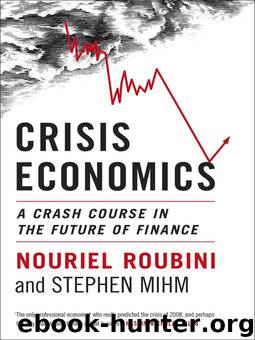Crisis Economics: A Crash Course in the Future of Finance by Nouriel Roubini & Stephen Mihm

Author:Nouriel Roubini & Stephen Mihm [Roubini, Nouriel & Mihm, Stephen]
Language: eng
Format: epub
Tags: Non-Fiction, Retail, Economics
ISBN: 9780143119630
Publisher: Penguin
Published: 2010-05-03T15:00:00+00:00
Chapter 8
First Steps
It’s a truism that crises go hand in hand with regulation and reform of the financial system. The near-death experience of a financial crisis pushes many people to contemplate what government can and should do to prevent another disaster. As Harvard economist Jeffrey Frankel wryly observed at the onset of the recent crisis: “They say there are no atheists in foxholes. Perhaps, then, there are also no libertarians in [financial] crises.”
Like so much else in crisis economics, this theme is recurrent. In 1826, the year after a speculative bubble collapsed in Britain, leaving behind scores of broken banks, Parliament passed legislation that overhauled the entire banking system. In the United States, the panic of 1907 left many lawmakers concerned about the nation’s lack of a central bank, and prompted the formation of the Federal Reserve a few years later.
The mother of all financial crises—the chain of disasters known as the Great Depression—sparked radical reforms of financial systems internationally. In the United States, the Glass-Steagall Act of 1933 created federal deposit insurance and established a firewall between commercial and investment banking; subsequent legislation gave the Federal Reserve the power to regulate bank reserves. The government brought the stock market to heel as well: the Securities Act of 1933 required issuers of securities to register them and to publish a prospectus, and it made the investment banks that underwrote the sale criminally liable for any errors or misleading statements in the prospectus. The following year saw the creation of the Securities and Exchange Commission, which remains the agency charged with regulating the buying and selling of securities. Though many other countries adopted similar measures, the United States implemented one of the most comprehensive series of reforms.
In light of this history, we might reasonably expect the United States once again to take the lead in reforming the financial system. The financial turmoil revealed fundamental weaknesses in the operation of U.S. and European financial markets and serious flaws in the existing system of supervision and regulation. But over the course of 2010, the urgent calls for reform faded, and legislation that would radically overhaul regulation and supervision had yet to see the light of day. Just like soldiers in foxholes abandoning their pledges to lead a better life as soon as the firing stops, lawmakers and policy makers now seem happy with the status quo.
There’s a perverse irony in all of this. Had policy makers failed to arrest the crisis, as they failed during the Depression, the calls for reform today would be deafening: there’s nothing like ubiquitous breadlines and 25 percent unemployment to focus the minds of legislators. But because the disaster was handled more deftly this time, the impetus for deep, structural reforms of the financial system has faltered. Instead, the surviving banks are paying out record bonuses, despite the fact that they owe their lives to government largesse.
This absence of reform is profoundly unfortunate. We live at a dangerous time, when the structural problems that created the crisis remain, even as aftershocks continue to rattle countries and economies around the world.
Download
This site does not store any files on its server. We only index and link to content provided by other sites. Please contact the content providers to delete copyright contents if any and email us, we'll remove relevant links or contents immediately.
Hit Refresh by Satya Nadella(8854)
The Compound Effect by Darren Hardy(8508)
Change Your Questions, Change Your Life by Marilee Adams(7371)
Nudge - Improving Decisions about Health, Wealth, and Happiness by Thaler Sunstein(7242)
The Black Swan by Nassim Nicholas Taleb(6762)
Deep Work by Cal Newport(6563)
Daring Greatly by Brene Brown(6222)
Rich Dad Poor Dad by Robert T. Kiyosaki(6174)
Principles: Life and Work by Ray Dalio(5960)
Man-made Catastrophes and Risk Information Concealment by Dmitry Chernov & Didier Sornette(5646)
Playing to Win_ How Strategy Really Works by A.G. Lafley & Roger L. Martin(5496)
Digital Minimalism by Cal Newport;(5389)
Big Magic: Creative Living Beyond Fear by Elizabeth Gilbert(5351)
The Myth of the Strong Leader by Archie Brown(5237)
The Slight Edge by Jeff Olson(5200)
Discipline Equals Freedom by Jocko Willink(5156)
The Motivation Myth by Jeff Haden(5001)
Stone's Rules by Roger Stone(4855)
The Laws of Human Nature by Robert Greene(4771)
